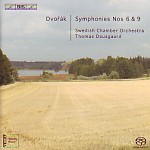Having Dvorák’s Sixth and Ninth symphonies on a single, 82-minute-plus CD certainly represents an enticing proposition, but in the end it turns out, in the famous words of W.S. Gilbert, to be a classic case of “modified rapture.” A cynical mind might well regard the title of the series from which these performances derive, “Opening Doors”, as a euphemism for “unidiomatic chamber orchestra performances of large Romantic works.” Granted, there’s a certain authenticity in playing the music this way; after all, in Dvorák’s day the music had to be adapted to local forces if it was to be heard at all. But there’s a big difference between making an uncomfortable accommodation out of necessity, and doing it on purpose when there is no longer any reason to short-change the composer’s evident intentions (never mind preserving the results for posterity on disc). Thomas Dausgaard is too intelligent a conductor not to be aware of these factors, and given the huge quantity of excellent repertoire for chamber orchestra, both old and new, it’s especially strange that he has chosen to pursue this misguided project.
That said, these performances are substantially superior to the previously released, cold-as-ice Schumann symphony release. Dausgaard offers lovingly phrased interpretations of both symphonies with plenty of tempo flexibility and no lack of character. The slow movement of the Sixth perhaps comes off best, played with a wonderful improvisatory freedom by the excellent Swedish Chamber Orchestra winds. In the famous second subject of the New World’s first movement, Dausgaard personalizes the music with touches of rubato and portamento, and if the result sounds more stylized than spontaneous, it’s still characterful and effective. But the positive qualities exemplified in these and other interesting details are largely nullified by the sheer lack of weight in the string section and by the unavoidable musical consequences that this entails.
For example, the opening of the New World’s finale sounds ridiculously undernourished, and the same holds true everywhere that Dvorák calls on the rich timbre of the massed strings (such as the codas of the Sixth Symphony’s outer movements). The brass need to be held back (trombones especially) at all of the climaxes. Nor does the use of chamber forces afford more transparency or textural detail. You can hear more of the woodwinds in the New World Symphony from Klemperer (EMI) and more of the Sixth’s all-important bass lines from Ancerl (Supraphon).
There are also a few miscalculations on Dausgaard’s part. The scherzo of the Sixth is taken too quickly, diminishing the impact of Dvorák’s heavily accented syncopated rhythms, particularly in the reprise of the main section where the off-beat timpani and brass chords fail to register as they do, say, for Kubelik (DG). And in the scherzo of the Ninth, Dausgaard’s loving attention to detail risks stasis in the trio section.
These are performances that you want to love. There is so much thought and talent behind the playing and conducting, and it’s obvious that everyone involved is doing their utmost to make the best possible case for their approach. But playing Dvorák this way is like pretending that you can fly without taking into account the force of gravity. It simply doesn’t work. Once again we see the danger of doing something simply because it’s possible, without taking into account whether it’s also desirable. As we find ourselves farther removed from the Romantic period, and the traditions of idiomatic performance become increasingly remote, it is clear that we cannot rely on the innate musicality of even excellent musicians to correctly make some very basic interpretive choices. Dausgaard and his band may have proven their point to the extent that they certainly can play this music, but why do it at Dvorák’s expense?
































